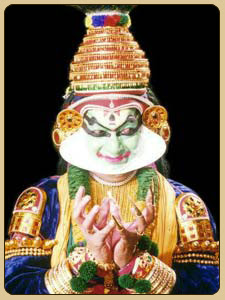Since the 17th century, an unusual form of sacred dance-drama called Krishnattam has existed in southwestern India. It is performed by a single company, originally attached to the court of Calicut and now under the sponsorship of the temple of Guruvayurappan, and the entire repertory is limited to eight plays, all concerning the god Krishna. Until the group visited Paris in 1980, few Westerners had ever seen any of these plays, for only Hindus are allowed inside the temple.
Therefore, a performance by the Krishnattam company on Thursday night at the Asia Society - its second appearance outside India - was a special occasion.
The all-male troupe of seven dancers, two singers and four drummers, directed by A. C. G. Raja, established the religious nature of their offering at the outset when attendants held a curtain in front of the audience while, behind it, the performers danced steps intended only for the eyes of the gods. At last, the curtain was dropped and what was revealed dazzled these mortal eyes.
Masked dancers were clad in elaborate costumes of almost blinding shades of red, black and gold. Their tiered headdresses rose like frosted layer cakes. Male and female characters alike wore wide and bulky bell-shaped skirts encrusted with decorations. Everything about Krishnattam looked both larger and stiffer than life. This became especially evident when the dancers posed beside the musicians and stage attendants. Whereas these simply clad figures came from our own world, the dancers inhabited the realm of myths and epics.
Given the overall heaviness of the dancing costumes, the performers' hands and feet seemed especially delicate protruding from them. Arm movements were carefully ceremonial and the feet either stamped rhythmically or shifted in measured patterns back and forth.
The program included excerpts from several dance-dramas. In the first, Krishna and his wife defeated a wicked warrior, with the aid of a magic bird. Then one of Krishna's companions tore apart another villain. This episode was followed by a plotless dance sequence, and the evening concluded with a benediction.
There were some interesting touches of characterization. Thus Krishna's wife was usually assigned demure, almost coy, poses. But when it came time to defend her husband, she boldly took up the necessary weapons.
The evening contained little of what Western audiences would consider dramatic suspense. But no such suspense was intended. What one saw was the re-enactment of timeless stories. To use a Western analogy, it was as if the glowing figures of saints and biblical characters in the stained-glass windows of a great cathedral had stepped down to remind us, through dancing, of their tribulations and triumphs.

No comments:
Post a Comment